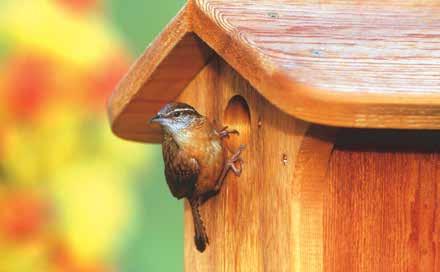
4 minute read
A Tale of Six Swallowtails
Friends excitedly tell me that they see Swallowtails in their yards. With equal excitement I reply, “Which ones?” Their excitement turns to confusion until I explain that we have six species of glorious Swallowtail butterflies, each with its own caterpillar host plant. As always, the more different caterpillar host plants, the more butterflies.
Swallowtails’ Similarities
foul odor of terpenes repel predators like ants, spiders and nosy humans.
We’re Not the Same!
The table illustrates the differences between the six species. Size won’t necessarily be a differentiator because it can depend on the time of year and the quantity/quality of the caterpillars’ food supply. And with six species/genders wearing black and blue, color doesn’t necessarily identify, except for the striking Zebra and the male Tiger Swallowtails.
The female Black Swallowtail is arguably the most common Swallowtail seen in Midwestern yards.
Many consider the Zebra Swallowtail to be our most beautiful butterfly. I agree.
A Tale of Six Swallowtails
Why Black and Blue?
Lenora Larson, May, 2023
Friends excitedly tell me that they see Swallowtails in their yards. With equal excitement I reply, “Which ones?” Their excitement turns to confusion until I explain that we have six species of glorious Swallowtail butterflies , each with its own caterpillar host plant As always, the more different caterpillar host plants, the more butterflies.
Swallowtail s’ Similarities
’
We
re Not the Same!
Over 500 species of the large colorful Swallowtails are found world-wide, mostly in the tropics. Six species are year-round residents of the Kansas City area, including the largest butterfly in North America, the Giant Swallowtail. All Swallowtails share common traits such as their striking tails sweeping down from their hind wings. An adult butterfly only lives about two weeks but all six species have multiple broods. If you have resident breeding populations in your yard, you will see them flying from early spring into early fall. None are migratory like the Monarch. Instead, they spend the winter in your yard as chrysalids attached by silken slings on low-lying stems and twigs. Overwintering Swallowtails are one of the many reasons that we nature lovers implore homeowners to minimize winter clean-up. Another commonality, all Swallowtail caterpillars have a forked smelly osmeterium that emerges from the prothoracic region when the caterpillar feels threatened. The
Many of our swallowtails, especially the females, have black and blue wings. Why? They are copying the black and blue Pipevine Swallowtail, the most poisonous butterfly in North America. If you ate a plateful of Pipevine Swallowtails you would get sick, maybe even die, from kidney failure because they contain aristolochic acid, which is sequestered by the caterpillar from eating the leaves of their poisonous Pipevine host plant. Only one nasty meal may dissuade a bird from eating any black and blue butterfly. We see the same “Batesian Mimicry” with Monarchs, which are poisonous because their caterpillars eat poisonous milkweeds. Many species of butterflies copy the Monarch’s orange and black coloration. Famously, the Viceroy and Painted Ladies do it best.
Add to the confusion when a black and blue Red-spotted Purple joins the party. It too is mimicking the Pipevine Swallowtail.
Why do black and blue colors predominate? Credit the Pipevine Swallowtail, North America’s most poisonous butterfly.
Over 500 species of the large colorful Swallowtails are found world -wide, mostly in the tropics Six species are year-round residents of the Kansas City area , including the largest butterfly in North America, the Giant Swallowtail. All Swallowtails share common traits such as their striking tails s weeping down from their hind wings. An adult butterfly only lives about two weeks but all six species have multiple broods If you have resident breeding population s in your yard, you will see them flying from early spring into early fall. None are migratory like the Monarch. Instead, they spend the winter in your yard as chrysalids attached by silken slings on lowlying stems and twigs. Overwintering Swallowtails are one of the many reasons that we nature lovers implore homeowners to minimize winter clean-up. Another commonality, a ll Swallowtail caterpillars have a forked smelly osmeterium that emerges from the prothoracic region when the caterpillar feels threatened. The foul odor of terpenes repel predators like ants, spiders and nosy humans
Resolving the Identity Crises
Most beginners are unaware that there are six different Swallowtails, but once they know, they may be even more frustrated by the challenges of identification. A good field guide such as A Photographic Field Guide to Butterflies in the Kansas City Region, authored by Betsy Betros and available on Amazon, provides multiple photographs of each species of butterfly, including by spring or summer, by male or female and the anterior (underwing) view. With these many clues and practice, you can identify with confidence. You may also realize that you need to plant host plants other than parsley, which only serves Black Swallowtails. Five other Swallowtail species await your host-plant invitation to your yard.
The table illustrates the differences between the six species . Size won’t necessarily be a differentiator because it can depend on the time of year and the quantity/quality of the caterpillars’ food supply And with 6 species/genders wearing black and blue, color doesn’t necessarily identify, except for the striking Zebra and the male Tiger Swallowtails.
Primary Upper Male
Wing Colors Female Black & Yellow Black & Yellow Yellow & Black Black & White Black & Blue Black & Sage Black & Yellow Black & Blue Black & Blue or Yellow & Black Black & White Black & Blue Black & Blue
Host Plant Family Citrus Carrot (and Rue) Rose, Magnolia Custard Apple Pipevine Spicebush
Favorite Host in KC
Area (my opinion) Prickly Ash Rue Fennel Parsley Tulip Poplar Cherry Paw Paw Pipevine Spicebush
Source: A Photographic Field Guide to Butterflies in the Kansas City Region , authored by Betsy Betros
Why Black and Blue?
LENORA LARSON Butterfly Maven
A Marais des Cygnes Master Gardener, Lenora is a member of the Idalia Butterfly Society and Kansas Native Plant Society. She gardens in the clay soil and cruel winds of Paola, KS. She may be contacted at lenora.longlips@gmail.com.
swallowtails, especially the females , have black and blue wings. Why? They are copying the black and blue Pipevine Swallowtail, the most poisonous butterfly in North America . If you ate a plateful of Pipevine Swallow tails you would get sick, maybe even from kidney failure because they contain aristolochic acid, which is sequestered by the caterpillar from eating the leaves of the Pipevine host plant Only one nasty meal may dissuade a bird from eating any black and blue butterfly We see the same “Batesian Mimicry” with Monarchs, which are poisonous because their caterpillars eat poisonous milkweeds . Many species of butterflies copy the Monarch’s orange and black coloration. Famously, the Viceroy and Pa inted Ladies do it best.
Resolving the Identity Crises










